A Solution to the Problem of Electrical Load Shedding Using Hybrid PV/Battery/Grid-Connected System: The Case of Households’ Energy Supply of the Northern Part of Cameroon
Abstract
1. Introduction
2. Presentation of the Current Energy Situation
2.1. Presentation of the Study Area
2.2. Current Energy Situation in the Study Area
3. Methodology
3.1. System Modeling
3.1.1. PV Output Model
3.1.2. Battery Storage Equation Model
3.1.3. The Main Grid Energy Supply Modeling
3.2. System Sizing and Optimization
The Objective Functions
3.3. Operational Strategy
- 1.
- When the grid connection is on, the grid energy supplies the load and the PV energy system charges the batteries. In this case, the energy charge of batteries and the grid energy supplied at the time interval Δt are given, respectively, by:and
- ➢
- If this excess PV energy is greater than or equal to the energy demand, then the grid energy supplied is zero because the total energy demand is satisfied by the PV energy system;
- ➢
- Whereas, if the excess PV energy is less than the energy demand, the grid energy supplied is the difference between the energy demand and the PV excess energy:
- 2.
- When the main grid is off, the total energy demand is supplied by the PV system.
- ➢
- If the PV energy is greater than or equal to the energy demand, the surplus PV energy charges the batteries. The energy charge of the batteries at the time interval Δt is then given by:
- ➢
- If the PV energy is less than the energy demand, the energy deficit is provided by the batteries:
- If the state of charge of the batteries is less than or equal to the minimum permissible state (0.2Cbat_max), the energy discharge of the batteries is zero;
- If the state of charge of the batteries is greater than the minimum permissible state and if the maximum dischargeable battery energy at the time interval Δt (Cbat (Δt) − 0.2Cbat_max) is greater than the energy deficit, then the energy supplied by the batteries and the capacity of the batteries at the time t are given by Equations (29) and (30), respectively.
- If the state of charge of the batteries is greater than the minimum permissible state, and if the maximum dischargeable battery energy at the time interval Δt is less than the energy deficit, then the energy supplied by the batteries and the capacity of the batteries at the time interval Δt are given by Equations (31) and (32), respectively.
4. Results and Discussion
5. Conclusions
Author Contributions
Funding
Institutional Review Board Statement
Informed Consent Statement
Data Availability Statement
Conflicts of Interest
Nomenclature
| Abbreviations | |
| PV | Photovoltaic |
| NOCT | Nominal operating cells temperature (°C) |
| SOC | State of charge of water in the reservoir |
| LPSP | Loss of power supply probability |
| NPC | Net present cost |
| FA | Firefly algorithm |
| Symbols | |
| Npv | Number of photovoltaic modules |
| Epv,out | Photovoltaic energy production (kW) |
| Epv | Photovoltaic energy supplied (kW) |
| Epv,ref | Photovoltaic energy at reference condition (25 °C or 298 K) (kW) |
| Ta | Ambient temperature (°C) |
| G | Solar radiation (kWh/m2) |
| Gref | Irradiance at reference condition (kW/m2) |
| GNOCT | Solar radiation at NOCT (kWh/m2) |
| Tc | Cell temperature (°C or K) |
| Tc,ref | Cell temperature at reference condition (25 °C or 298 K) |
| Epv | Photovoltaic daily energy production |
| Iter | Iteration |
| Iter_max | Maximum number of iterations |
| Cbat | Storage capacity of batteries (kWh or kAh) |
| Cbat_max | Maximum storage capacity of batteries (kWh or kAh) |
| Un | Nominal voltage of battery bank (V) |
| Ebat_c | Energy of charge of batteries (kWh) |
| Ebat_disch | Energy of discharge of batteries (kWh) |
| Epv,s | PV energy supplied (kWh) |
| Epv,c | PV energy consumed (kWh) |
| Es | Energy supplied to load (kWh) |
| Esurplus | Surplus of enery (kWh) |
| Esurplus_maroua | Monthly surplus of energy corresponding to Maroua |
| Esurplus_garoua | Monthly surplus of energy corresponding to Garoua |
| Esurplus_ngaoundéré | Monthly surplus of energy corresponding to Ngaoundéré |
| Eb,d | Battery energy discharged (kWh) |
| Cbatt | Storage capacity of batteries (kWh or kAh) |
| Esupply | Energy supplied to load |
| Ed | Energy demand |
| EG | Grid energy supplied |
| Nad | Number of autonomy days of batteries |
| Costpv | Cost of photovoltaic modules |
| Costreservoir | Cost of reservoir |
| Costregulator | Cost of regulator |
| Greek symbols | |
| α | Temperature coefficient of short-circuit current (A/K) |
| ηinv | Inverter efficiency |
| ηregul | Regulator efficiency |
| ηbat_c | Efficiency of charge of batteries (%) |
| ηbat_disch | Efficiency of discharge of batteries (%) |
| USD | American US dollar |
References
- World Economic Forum. Available online: https://www.weforum.org/agenda/2019/05/patchy-progress-on-electricity-access-casts-shadow-on-global-goal (accessed on 25 March 2021).
- Husna, S.; Abdullah, M.P.; Faridiansyah, I. An improved load shedding scheduling strategy for solving power supply defisit. J. Teknol. 2016, 78, 5–7. [Google Scholar]
- Hirodontis, S.; Li, H.; Crossley, P.A. Load shedding in a distribution network. In Proceedings of the International Conference on Sustainable Power Generation and Supply, Nanjing, China, 6–7 April 2009. [Google Scholar]
- Faranda, R.; Pievatolo, A.; Tironi, E. Load shedding: A new proposal. IEEE Trans. Power Syst. 2007, 22, 2086–2093. [Google Scholar] [CrossRef]
- Crampes, C.; Léautier, T.O. Distributed load-shedding in the balancing of electricity markets. In Proceedings of the 9th International Conference on the European Energy Market, Florence, Italy, 10–12 May 2012. [Google Scholar]
- Emar, W.; Al-Barami, G.S. Economical Motivation and Benefits of using Load Shedding in Energy Management Systems. Int. J. Adv. Comput. Sci. Appl. 2019, 10, 204–209. [Google Scholar] [CrossRef]
- Margaret, V.; Rao, K.U.; Ganeshprasad, G.G. Intelligent load shedding using ant colony algorithm in smart grid environment. Power Electron. Renew. Energy Syst. 2015, 1149–1162. [Google Scholar] [CrossRef]
- Ullah, I.; Rasheed, M.B.; Alquthami, T.; Tayyaba, S. A Residential Load Scheduling with the Integration of On-Site PV and Energy Storage Systems in Micro-Grid. Sustainability 2019, 12, 184. [Google Scholar] [CrossRef]
- Alramlawi, M.; Gabash, A.; Mohagheghi, E.; Li, P. Optimal operation of hybrid PV-battery system considering grid scheduled blackouts and battery lifetime. Solar Energy 2018, 161, 125–137. [Google Scholar] [CrossRef]
- Bastholm, C.; Fiedler, F. Techno-economic study of the impact of blackouts on the viability of connecting an off-grid PV-diesel hybrid system in Tanzania to the national power grid. Bastholm, Caroline, and Frank Fiedler. Techno-economic study of the impact of blackouts on the viability of connecting an off-grid PV-diesel hybrid system in Tanzania to the national power grid. Energy Convers. Manag. 2018, 171, 647–658. [Google Scholar]
- Alibakhsh, K.; Rahdan, P.; Rad, M.A.V.; Yan, W.M. Optimal design and technical analysis of a grid-connected hybrid photovoltaic/diesel/biogas under different economic conditions: A case study. Energy Convers. Manag. 2019, 198, 111810. [Google Scholar]
- Samy, M.M.; Mosaad, M.I.; Barakat, S. Optimal economic study of hybrid PV-wind-fuel cell system integrated to unreliable electric utility using hybrid search optimization technique. Int. J. Hydrog. Energy 2021, 46, 11217–11231. [Google Scholar] [CrossRef]
- Murphy, P.M.; Ssennoga, T.; Murphy, I.S. Analysis of the cost of reliable electricity: A new method for analyzing grid connected solar, diesel and hybrid distributed electricity systems considering an unreliable electric grid, with examples in Uganda. Energy 2014, 66, 523–534. [Google Scholar] [CrossRef]
- Saleh, A.A.; NaimTajuddin, M.F.; Adzman, M.R.; Mohammed, M.F.; Ramli, M.A.M. Feasibility analysis of grid-connected and islanded operation of a solar PV microgrid system: A case study of Iraq. Energy 2020, 191, 116591. [Google Scholar]
- Adefarati, T.; Bansal, R.C. The Impacts of PV-Wind-Diesel-Electric Storage Hybrid System on the Reliability of a Power System. Energy Procedia 2017, 105, 616–621. [Google Scholar] [CrossRef]
- Maleki, A.; Rosen, M.A.; Pourfayaz, F. Optimal operation of a grid-connected hybrid renewable energy system for residential applications. Sustainability 2017, 9, 1314. [Google Scholar] [CrossRef]
- Miceli, R. Energy management and smart grids. Energies 2013, 6, 2262–2290. [Google Scholar] [CrossRef]
- Oyekale, J.; Petrollese, M.; Tola, V.; Cau, G. Impacts of Renewable Energy Resources on Effectiveness of Grid-Integrated Systems: Succinct Review of Current Challenges and Potential Solution Strategies. Energies 2020, 13, 4856. [Google Scholar] [CrossRef]
- Javaid, N.; Ullah, I.; Akbar, M.; Iqbal, Z.; Khan, F.A.; Alrajeh, N.; Alabed, M.S. An intelligent load management system with renewable energy integration for smart homes. IEEE Access 2017, 5, 13587–13600. [Google Scholar] [CrossRef]
- Armin, R.A.; Sumper, A.; Davarpanah, A. Energy sustainability analysis based on SDGs for developing countries. Energy Sources Part A Recovery Util. Environ. Eff. 2020, 42, 1041–1056. [Google Scholar] [CrossRef]
- Chakir, A.; Tabaa, M.; Moutaouakkil, F.; Medromi, H.; Alami, K. Smart multi-level energy management algorithm for grid-connected hybrid renewable energy systems in a micro-grid context. Energy 2020, 12, 055301. [Google Scholar]
- Armin, R.A.; Sumper, A.; Davarpanah, A. Development of sustainable energy indexes by the utilization of new indicators: A comparative study. Energy Rep. 2019, 5, 375–383. [Google Scholar] [CrossRef]
- Mansour, A.; Gabash, A.; Li, P. Optimal Operation Strategy of a Hybrid PV-Battery System under Grid Scheduled Blackouts. In Proceedings of the2017 IEEE International Conference on Environment and Electrical Engineering and 2017 IEEE Industrial and Commercial Power Systems Europe (EEEIC/I&CPS Europe), Milan, Italy, 6–9 June 2017. [Google Scholar]
- Le problème de l’industrialisation du Cameroun. Available online: http://georepere.e-monsite.com/medias/files/chap.26.industrialisation.dun.cameroun.pdf (accessed on 7 April 2021).
- Photovoltaic Geographical Information System. Available online: https://re.jrc.ec.europa.eu/pvg_tools/fr/#PVP (accessed on 7 February 2021).
- PopulationData.net. Available online: https://www.populationdata.net/pays/cameroun/ (accessed on 25 March 2021).
- Yahia, B.; Arab, A.H.; Azoui, B. Optimal sizing of photovoltaic pumping system with water tank storage using LPSP concept. Sol. Energy 2011, 85, 288–294. [Google Scholar]
- Fadaee, M.; Radzi, M.A.M. Multi-objective optimization of a stand-alone hybrid renewable energy system by using evolutionary algorithms: A review. Renew. Sustain. Energy Rev. 2012, 16, 3364–3369. [Google Scholar] [CrossRef]
- Ma, T.; Yang, H.; Lu, L.; Peng, J. Pumped storage-based standalone photovoltaic power generation system: Modeling and techno-economic optimization. Appl. Energy 2015, 137, 649–659. [Google Scholar] [CrossRef]
- Mahmoudimehr, J.; Shabani, M. Optimal design of hybrid photovoltaic-hydroelectric standalone energy system for north and south of Iran. Renew. Energy 2018, 115, 238–251. [Google Scholar] [CrossRef]
- Yang, H.; Zhou, W.; Lu, L.; Fang, Z. Optimal sizing method for stand-alone hybrid solar–wind system with LPSP technology by using genetic algorithm. Sol. Energy 2008, 82, 354–367. [Google Scholar] [CrossRef]
- Koutroulis, E.; Kolokotsa, D.; Potirakis, A.; Kalaitzakis, K. Methodology for optimal sizing of stand-alone photovoltaic/wind-generator systems using genetic algorithms. Sol. Energy 2006, 80, 1072–1088. [Google Scholar] [CrossRef]
- Abdelkader, A.; Rabeh, A.; Ali, D.M.; Mohamed, J. Multi-objective genetic algorithm based sizing optimization of a stand-alone Wind/PV power supply system with enhanced battery/supercapacitor hybrid energy storage. Energy 2018, 163, 351–363. [Google Scholar] [CrossRef]
- Mahesh, A.; Sandhu, K.S. A genetic algorithm based improved optimal sizing strategy for solar-wind-battery hybrid system using energy filter algorithm. Front. Energy 2020, 14, 139–151. [Google Scholar] [CrossRef]
- Chandel, S.S.; Nagaraju, N.M.; Chandel, R. Review of solar photovoltaic water pumping system technology for irrigation and community drinking water supplies. Renew. Sustain. Energy Rev. 2015, 49, 1084–1099. [Google Scholar] [CrossRef]
- Niknam, P.H.; Talluri, L.; Fiaschi, D.; Manfrida, G. Improved Solubility Model for Pure Gas and Binary Mixture of CO2-H2S in Water: A Geothermal Case Study with Total Reinjection. Energies 2020, 13, 2883. [Google Scholar] [CrossRef]
- Yang, X.S. Firefly algorithm, stochastic test functions and design optimization. Int. J. Bio-Inspired Comput. 2010, 2, 78–84. [Google Scholar] [CrossRef]
- Yang, X.S. Nature-Inspired Optimization Algorithms; Elsevier: Amsterdam, The Netherlands, 2014; ISBN 978-0-12-416743-8. [Google Scholar] [CrossRef]
- Yang, X.S. Firefly Algorithms for Multimodal Optimization, International Symposium on Stochastic Algorithms; Springer: Berlin/Heidelberg, Germany, 2009; pp. 169–178. [Google Scholar]
- Yang, X.S. Multiobjective firefly algorithm for continuous optimization. Eng. Comput. 2013, 29, 175–184. [Google Scholar] [CrossRef]


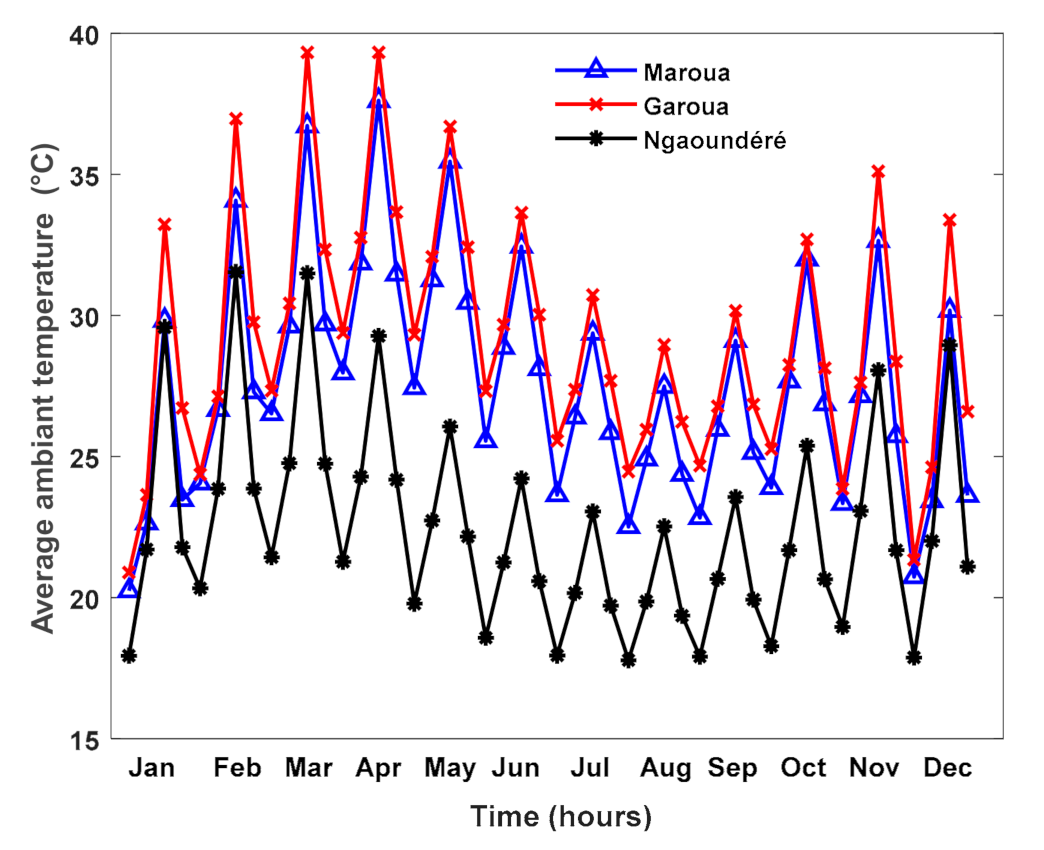
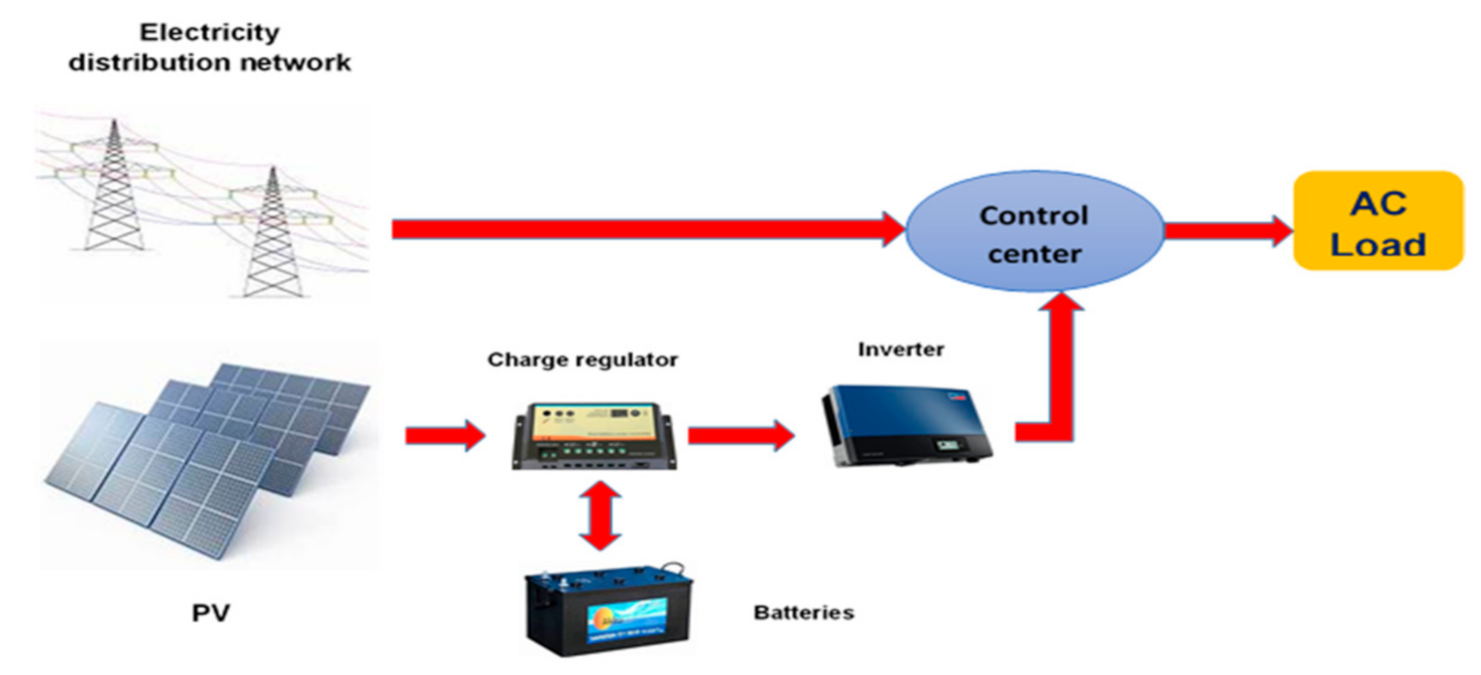
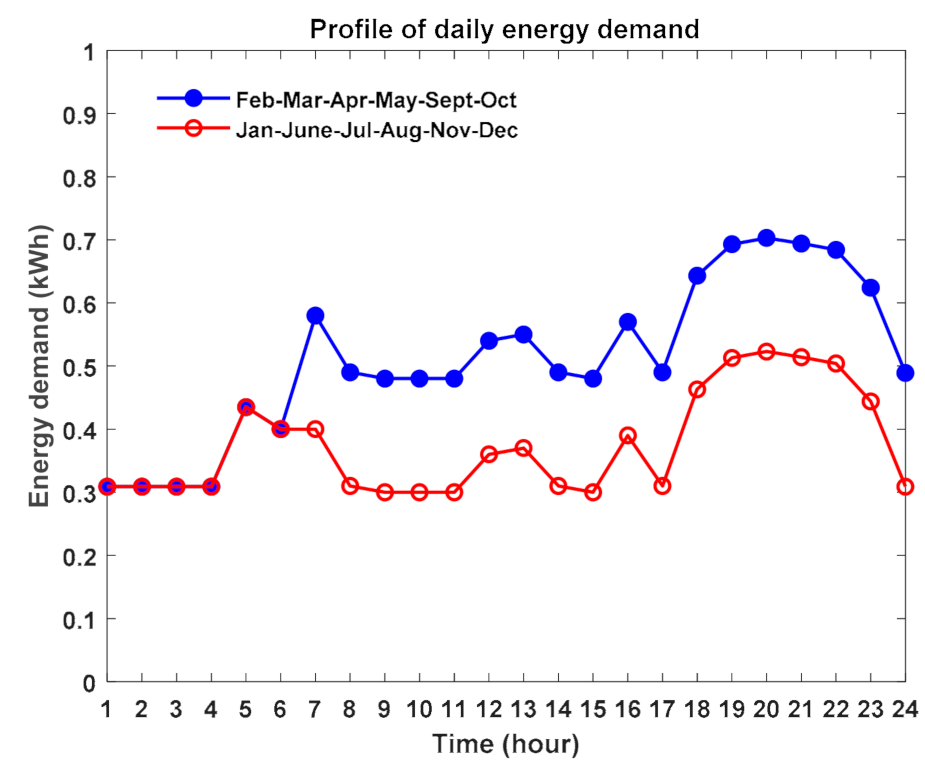

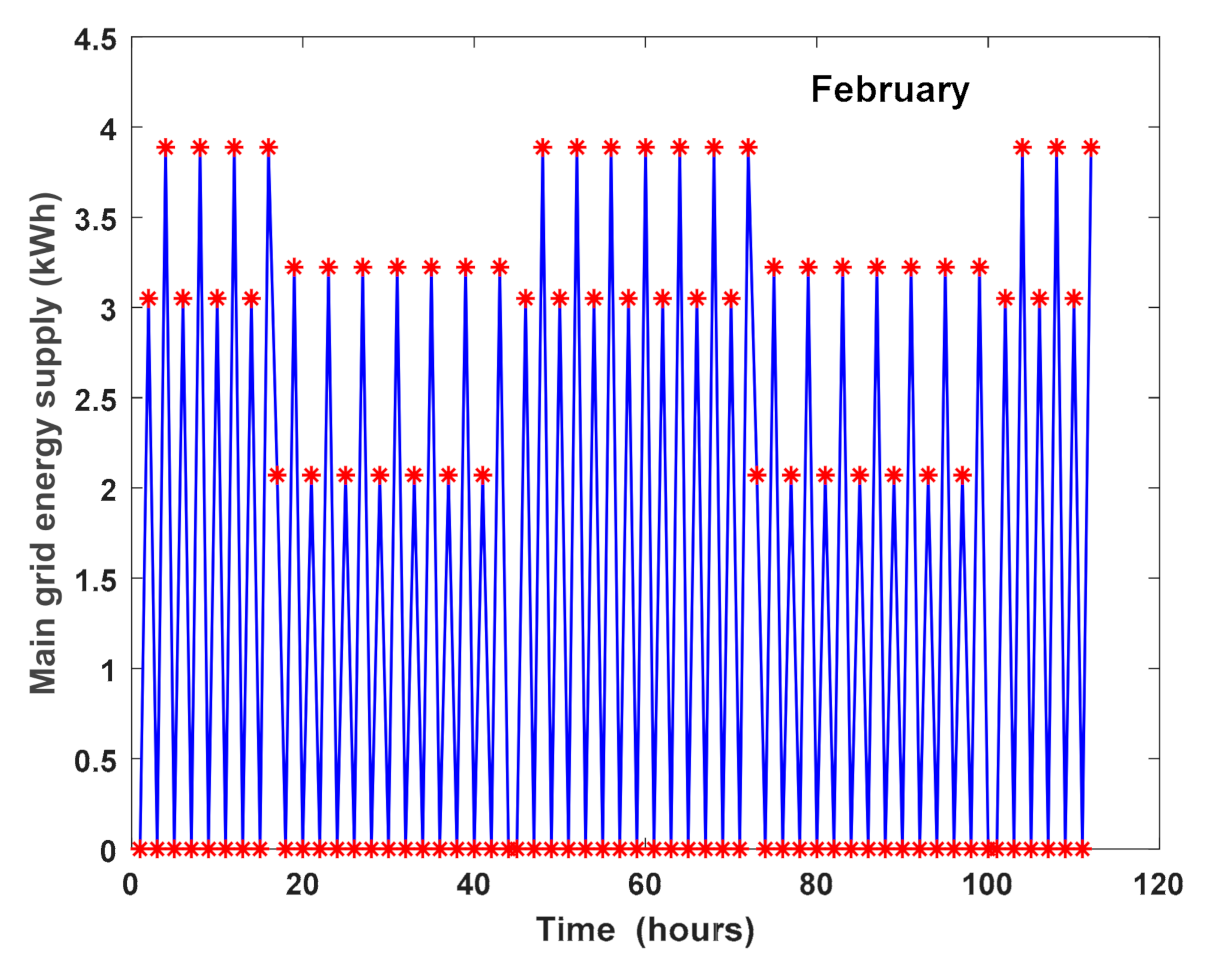

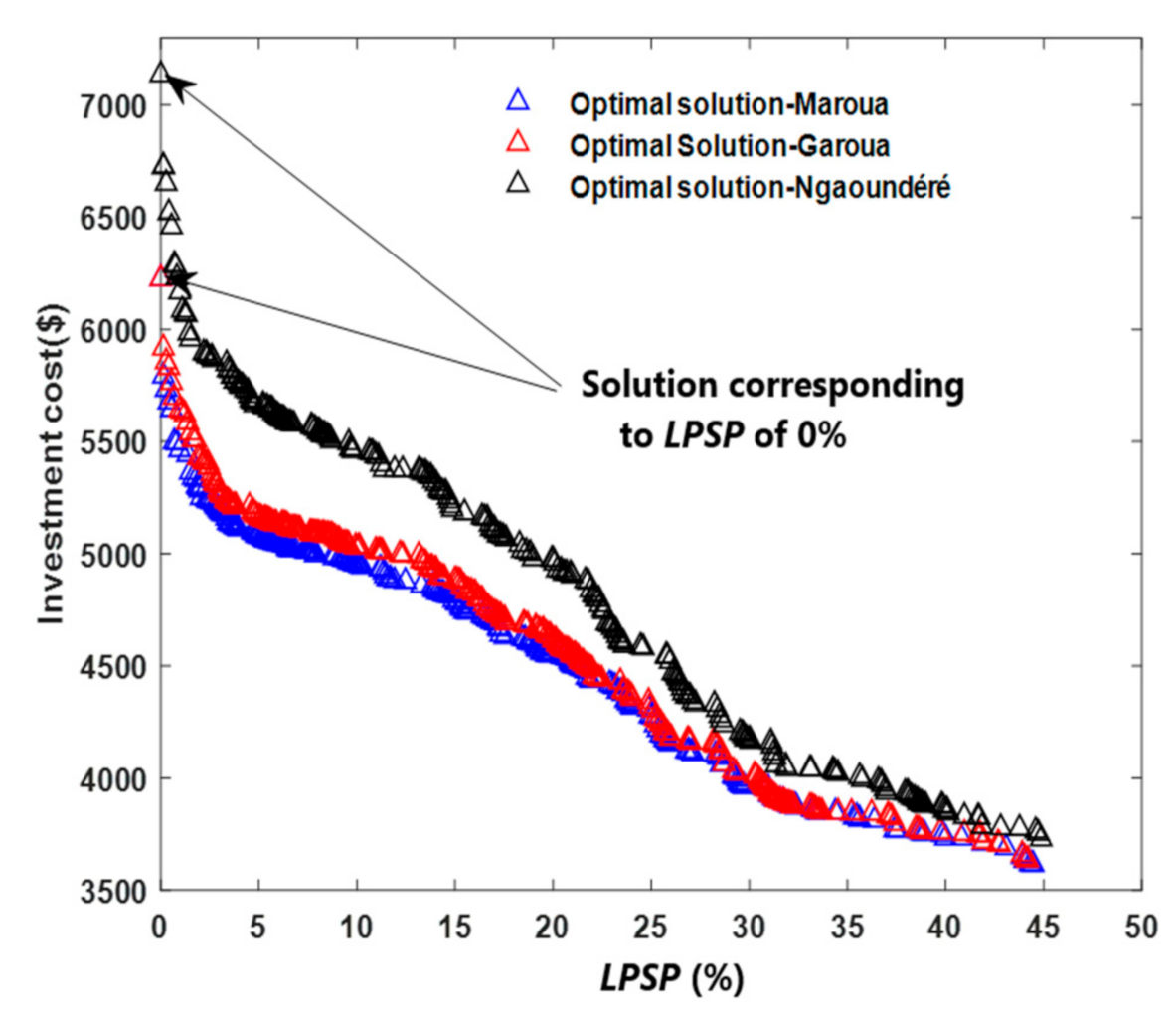
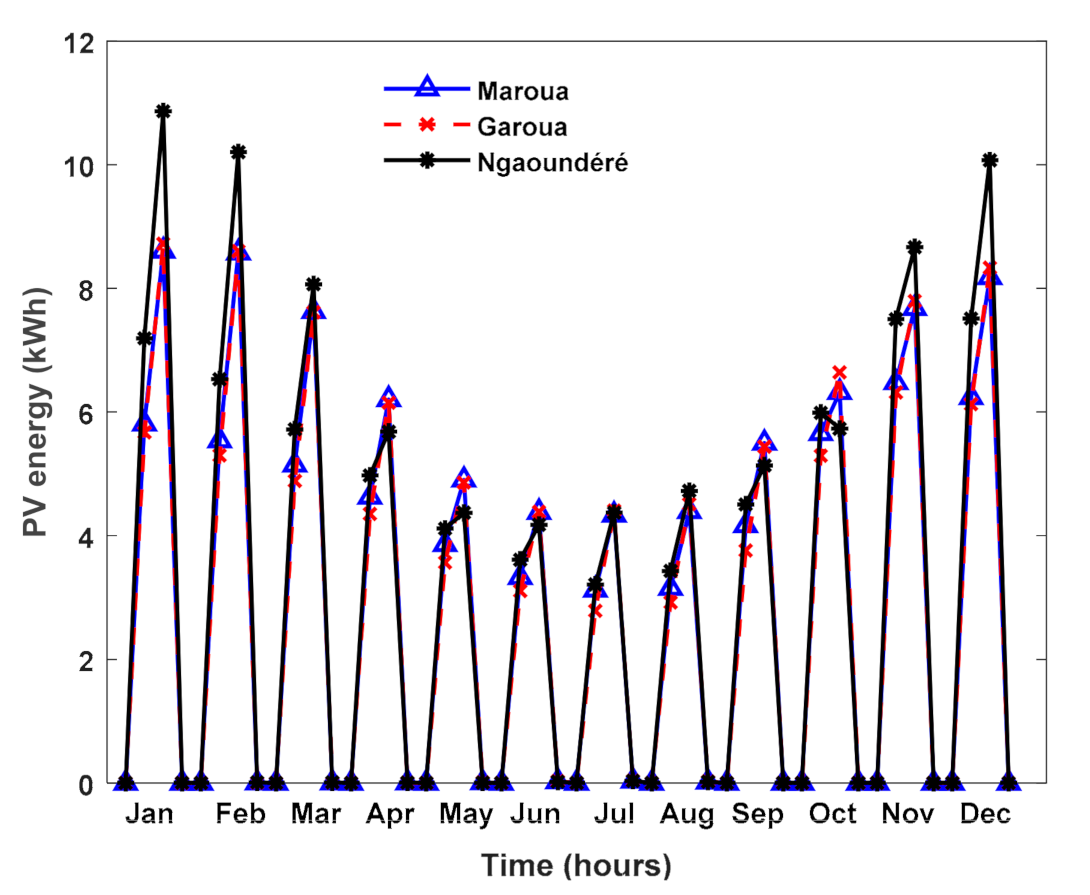




| Designation | Quantity | Power (W) Unit | February–May | June–August | September–October | November–January | ||||
|---|---|---|---|---|---|---|---|---|---|---|
| h/d | Wh/d | h/d | Wh/d | h/d | Wh/d | h/d | Wh/d | |||
| Lighting | 7 | 9 | 7 | 441 | 7 | 441 | 7 | 441 | 7 | 441 |
| Television | 1 | 60 | 6 | 360 | 6 | 360 | 6 | 360 | 6 | 360 |
| Radio | 1 | 10 | 9 | 90 | 9 | 90 | 9 | 90 | 9 | 90 |
| Ceiling fan | 4 | 45 | 18 | 3240 | 0 | 0 | 18 | 3240 | 0 | 0 |
| Computer | 2 | 45 | 10 | 900 | 10 | 900 | 10 | 900 | 10 | 900 |
| Refrigerator | 1 | 300 | 24 | 7200 | 24 | 7200 | 24 | 7200 | 24 | 7200 |
| Total | 12,231 | 8991 | 12,231 | 8991 | ||||||
| Time Variation (Hours) | Δt1 (1 h–7 h) | Δt2 (7 h–13 h) | Δt3 (13 h–19 h) | Δt4 (19 h–1 h) |
|---|---|---|---|---|
| Energy demand (kWh) (Feb.-Mar.-Apr.-May-Sept.-Oct.) | 2.071 | 3.050 | 3.223 | 3.887 |
| Energy demand (kWh) (Jan.-June-July-Aug.-Nov.-Dec.) | 2.071 | 1.970 | 2.143 | 2.807 |
| Time Slots | 1 h–7 h | 7 h–13 h | 13 h–19 h | 19 h–1 h |
|---|---|---|---|---|
| Grid connection: week 1 | Yes | No | Yes | No |
| Grid connection: week 2 | No | Yes | No | Yes |
| Designation | Unit | Cost (USD) | Lifetime (year) |
|---|---|---|---|
| PV array | W | 1 | 25 |
| Batteries | Ah | 1.63 | 8 |
| Inverter | kW | 896 | 15 |
| Charge regulator | kW | 450 | 15 |
| City | LPSP (%) | Number of PV Modules | Autonomy of Batteries (Days) | Capacity of Batteries (kWh) | Investment Cost (USD) |
|---|---|---|---|---|---|
| Maroua | 0 | 8 | 1 | 11.304 | 6225.6 |
| Garoua | 0 | 8 | 1 | 11.304 | 6225.6 |
| Ngaoundéré | 0 | 10 | 1 | 11.304 | 7136.6 |
| City | Month (mth) | Ed (kWh) | EG (kWh) | EPV,s (kWh) | Epv,c (kWh) | Eb,d (kWh) | Es = EG + Epv,c + Eb,d (kWh) | Esurplus = Epv,s − Epv,c − Eb,d (kWh) |
|---|---|---|---|---|---|---|---|---|
| Maroua | January | 278.721 | 78.445 | 446.970 | 123.563 | 76.713 | 278.721 | 246.694 |
| February | 342.468 | 94.019 | 395.270 | 165.061 | 83.388 | 342.468 | 146.821 | |
| March | 379.161 | 104.898 | 396.260 | 179.279 | 94.984 | 379.161 | 121.997 | |
| April | 366.930 | 125.821 | 325.020 | 151.818 | 89.291 | 366.930 | 83.911 | |
| May | 379.161 | 169.164 | 271.820 | 120.469 | 89.528 | 379.161 | 61.823 | |
| June | 269.730 | 102.668 | 231.940 | 94.941 | 72.121 | 269.730 | 64.878 | |
| July | 278.721 | 110.412 | 232.310 | 93.553 | 74.756 | 278.721 | 64.001 | |
| August | 278.721 | 105.078 | 234.370 | 97.217 | 76.426 | 278.721 | 60.727 | |
| September | 366.930 | 143.614 | 289.890 | 132.130 | 91.186 | 366.960 | 66.574 | |
| October | 379.161 | 107.878 | 371.240 | 181.658 | 89.625 | 379.161 | 99.957 | |
| November | 269.730 | 76.374 | 424.740 | 119.450 | 73.906 | 269.730 | 231.384 | |
| December | 278.721 | 81.151 | 446.870 | 121.593 | 75.977 | 278.721 | 249.300 | |
| Garoua | January | 278.721 | 78.445 | 446.150 | 123.563 | 76.713 | 278.721 | 245.874 |
| February | 342.468 | 96.869 | 389.341 | 162.260 | 83.339 | 342.468 | 143.742 | |
| March | 379.161 | 107.983 | 387.659 | 176.224 | 94.954 | 379.161 | 116.481 | |
| April | 366.930 | 133.995 | 315.216 | 143.644 | 89.291 | 366.930 | 82.281 | |
| May | 379.161 | 178.326 | 261.487 | 111.333 | 89.502 | 379.161 | 60.652 | |
| June | 269.730 | 107.785 | 225.551 | 89.899 | 72.046 | 269.730 | 63.606 | |
| July | 278.721 | 116.028 | 224.184 | 88.019 | 74.674 | 278.721 | 61.491 | |
| August | 278.721 | 108.781 | 231.080 | 93.604 | 76.336 | 278.721 | 61.140 | |
| September | 366.930 | 154.133 | 275.978 | 121.639 | 91.158 | 366.930 | 63.181 | |
| October | 379.161 | 112.949 | 369.930 | 176.587 | 89.625 | 379.161 | 103.718 | |
| November | 269.730 | 76.374 | 423.488 | 119.450 | 73.906 | 269.730 | 230.132 | |
| December | 278.721 | 81.151 | 448.428 | 121.593 | 75.977 | 278.721 | 250.858 | |
| Ngaoundéré | January | 278.721 | 77.529 | 559.851 | 124.514 | 76.678 | 278.721 | 358.659 |
| February | 342.468 | 89.394 | 468.794 | 169.780 | 83.294 | 342.468 | 215.720 | |
| March | 379.161 | 97.973 | 427.605 | 186.259 | 94.929 | 379.161 | 146.417 | |
| April | 366.930 | 124.216 | 319.846 | 153.439 | 89.275 | 366.930 | 77.132 | |
| May | 379.161 | 170.568 | 263.116 | 119.026 | 89.567 | 379.161 | 54.523 | |
| June | 269.730 | 98.434 | 234.205 | 99.124 | 72.172 | 269.730 | 62.909 | |
| July | 278.721 | 108.049 | 236.098 | 95.928 | 74.744 | 278.721 | 65.426 | |
| August | 278.721 | 96.235 | 253.322 | 106.089 | 76.397 | 278.721 | 70.836 | |
| September | 366.930 | 140.516 | 289.226 | 135.228 | 91.186 | 366.930 | 62.812 | |
| October | 379.161 | 104.223 | 363.278 | 185.313 | 89.625 | 379.161 | 88.340 | |
| November | 269.730 | 74.873 | 485.050 | 120.951 | 73.906 | 269.730 | 290.193 | |
| December | 278.721 | 78.866 | 545.147 | 123.878 | 75.977 | 278.721 | 345.292 |
| City | Month | Ed (kWh) | EG (kWh) | Epv,c (kWh) | Eb,d (kWh) | EG/Ed (%) | Epv,c/Ed (%) | Eb,d/Ed (%) | PV + Batt (%) |
|---|---|---|---|---|---|---|---|---|---|
| Maroua | January | 278.721 | 78.445 | 123.563 | 76.713 | 28.144 | 44.332 | 27.523 | 71.855 |
| February | 342.468 | 94.019 | 165.061 | 83.388 | 27.453 | 48.197 | 24.349 | 72.546 | |
| March | 379.161 | 104.898 | 179.279 | 94.984 | 27.665 | 47.282 | 25.051 | 72.334 | |
| April | 366.930 | 125.821 | 151.818 | 89.291 | 34.290 | 41.375 | 24.334 | 65.709 | |
| May | 379.161 | 169.164 | 120.469 | 89.528 | 44.615 | 31.772 | 23.612 | 55.384 | |
| June | 269.730 | 102.668 | 94.941 | 72.121 | 38.063 | 35.198 | 26.738 | 61.936 | |
| July | 278.721 | 110.412 | 93.553 | 74.756 | 39.614 | 33.565 | 26.820 | 60.385 | |
| August | 278.721 | 105.078 | 97.217 | 76.426 | 37.700 | 34.879 | 27.42 | 62.299 | |
| September | 366.930 | 143.614 | 132.130 | 91.186 | 39.139 | 36.009 | 24.851 | 60.860 | |
| October | 379.161 | 107.878 | 181.658 | 89.625 | 28.451 | 47.910 | 23.637 | 71.548 | |
| November | 269.730 | 76.374 | 119.450 | 73.906 | 28.314 | 44.285 | 27.399 | 71.685 | |
| December | 278.721 | 81.151 | 121.593 | 75.977 | 29.115 | 43.625 | 27.259 | 70.884 | |
| Garoua | January | 278.721 | 78.445 | 123.563 | 76.713 | 28.144 | 44.332 | 27.523 | 71.855 |
| February | 342.468 | 96.869 | 162.260 | 83.339 | 28.285 | 47.379 | 24.334 | 71.714 | |
| March | 379.161 | 107.983 | 176.224 | 94.954 | 28.479 | 46.477 | 25.043 | 71.520 | |
| April | 366.930 | 133.995 | 143.644 | 89.291 | 36.517 | 39.147 | 24.334 | 63.482 | |
| May | 379.161 | 178.326 | 111.333 | 89.502 | 47.031 | 29.363 | 23.605 | 52.968 | |
| June | 269.730 | 107.785 | 89.899 | 72.046 | 39.960 | 33.329 | 26.710 | 60.039 | |
| July | 278.721 | 116.028 | 88.019 | 74.674 | 41.628 | 31.579 | 26.791 | 58.371 | |
| August | 278.721 | 108.781 | 93.604 | 76.336 | 39.028 | 33.583 | 27.387 | 60.971 | |
| September | 366.930 | 154.133 | 121.639 | 91.158 | 42.006 | 33.150 | 24.843 | 57.993 | |
| October | 379.161 | 112.949 | 176.587 | 89.625 | 29.789 | 46.573 | 23.637 | 70.210 | |
| November | 269.730 | 76.374 | 119.450 | 73.906 | 28.314 | 44.285 | 27.399 | 71.685 | |
| December | 278.721 | 81.151 | 121.593 | 75.977 | 29.115 | 43.625 | 27.259 | 70.884 | |
| Ngaoundéré | January | 278.721 | 77.529 | 124.514 | 76.678 | 27.815 | 44.673 | 27.510 | 72.184 |
| February | 342.468 | 89.394 | 169.780 | 83.294 | 26.102 | 49.575 | 24.321 | 73.897 | |
| March | 379.161 | 97.973 | 186.259 | 94.929 | 25.839 | 49.124 | 25.036 | 74.160 | |
| April | 366.930 | 124.216 | 153.439 | 89.275 | 33.852 | 41.816 | 24.330 | 66.147 | |
| May | 379.161 | 170.568 | 119.026 | 89.567 | 44.985 | 31.391 | 23.622 | 55.014 | |
| June | 269.730 | 98.434 | 99.124 | 72.172 | 36.493 | 36.749 | 26.757 | 63.506 | |
| July | 278.721 | 108.049 | 95.928 | 74.744 | 38.766 | 34.417 | 26.816 | 61.233 | |
| August | 278.721 | 96.235 | 106.089 | 76.397 | 34.527 | 38.062 | 27.409 | 65.472 | |
| September | 366.930 | 140.516 | 135.228 | 91.186 | 38.294 | 36.853 | 24.851 | 61.705 | |
| October | 379.161 | 104.223 | 185.313 | 89.625 | 27.487 | 48.874 | 23.637 | 72.512 | |
| November | 269.730 | 74.873 | 120.951 | 73.906 | 27.758 | 44.841 | 27.399 | 72.241 | |
| December | 278.721 | 78.866 | 123.878 | 75.977 | 28.295 | 44.444 | 27.259 | 71.704 |
| Month | Epv,s/Esurplus_maroua (%) | Epv,s/Esurplus_garoua (%) | Epv,s/Esurplus_ngaoundéré (%) |
|---|---|---|---|
| January | 55.192 | 55.110 | 64.063 |
| February | 37.144 | 36.919 | 46.015 |
| March | 30.787 | 30.047 | 34.241 |
| April | 25.817 | 26.103 | 24.115 |
| May | 22.744 | 23.194 | 20.722 |
| June | 27.972 | 28.200 | 26.860 |
| July | 27.550 | 27.428 | 27.711 |
| August | 25.911 | 26.458 | 27.963 |
| September | 22.965 | 22.893 | 21.717 |
| October | 26.925 | 28.037 | 24.317 |
| November | 54.476 | 54.342 | 59.827 |
| December | 55.788 | 55.941 | 63.339 |
| Annual average percentage of surplus of energy (%) | 34.439 | 34.556 | 36.741 |
| Energy Supply Configuration | Only Grid Connection without Power Shedding | Only Grid Connection with Power Shedding | PV Energy Production System | Grid Connection with Power Shedding + PV System | |||
|---|---|---|---|---|---|---|---|
| City | Year | Energy Consumed (kWh) | Total Cost of Energy (USD) | Energy Consumed (kWh) | Total Cost of Energy (USD) | Total Investment Cost (USD) | Total Cost (USD) |
| Maroua | 1 | 3868.155 | 558.736 | 1299.524 | 187.710 | 6225.6 | 6413.310 |
| 2 | 7736.310 | 1117.473 | 2599.049 | 375.420 | 6225.6 | 6601.020 | |
| 3 | 11,604.465 | 1676.209 | 3898.573 | 563.130 | 6225.6 | 6788.730 | |
| 4 | 15,472.62 | 2234.946 | 5198.098 | 750.840 | 6225.6 | 6976.440 | |
| 5 | 19,340.775 | 2793.683 | 6497.622 | 938.550 | 6225.6 | 7164.150 | |
| 6 | 23,208.93 | 3352.419 | 7797.147 | 1126.260 | 6225.6 | 7351.860 | |
| 7 | 27,077.085 | 3911.156 | 9096.671 | 1313.971 | 6225.6 | 7539.571 | |
| 8 | 30,945.24 | 4469.893 | 10,396.196 | 1501.681 | 6225.6 | 7727.281 | |
| 9 | 34,813.395 | 5028.629 | 11,695.720 | 1689.391 | 6225.6 | 7914.991 | |
| 10 | 38,681.550 | 5587.366 | 12,995.245 | 1877.101 | 6225.6 | 8102.701 | |
| 11 | 42,549.705 | 6146.103 | 14,294.769 | 2064.811 | 6225.6 | 8290.411 | |
| 12 | 46,417.860 | 6704.839 | 15,594.294 | 2252.521 | 6225.6 | 8478.121 | |
| 13 | 50,286.015 | 7263.576 | 16,893.818 | 2440.231 | 6225.6 | 8665.831 | |
| 14 | 54,154.170 | 7822.313 | 18,193.343 | 2627.942 | 6225.6 | 8853.542 | |
| 15 | 58,022.325 | 8381.049 | 19,492.867 | 2815.652 | 6225.6 | 9041.252 | |
| 16 | 61,890.480 | 8939.786 | 20,792.392 | 3003.362 | 6225.6 | 9228.962 | |
| 17 | 65,758.635 | 9498.522 | 22,091.916 | 3191.072 | 6225.6 | 9416.672 | |
| 18 | 69,626.790 | 10,057.259 | 23,391.441 | 3378.782 | 6225.6 | 9604.382 | |
| 19 | 73,494.945 | 10,615.996 | 24,690.965 | 3566.492 | 6225.6 | 9792.092 | |
| 20 | 77,363.100 | 11,174.732 | 25,990.490 | 3754.203 | 6225.6 | 9979.803 | |
| 21 | 81,231.255 | 11,733.469 | 27,290.014 | 3941.913 | 6225.6 | 10,167.513 | |
| 22 | 85,099.410 | 12,292.206 | 28,589.539 | 4129.623 | 6225.6 | 10,355.223 | |
| 23 | 88,967.565 | 12,850.942 | 29,889.063 | 4317.333 | 6225.6 | 10,542.933 | |
| 24 | 92,835.720 | 13,409.679 | 31,188.588 | 4505.043 | 6225.6 | 10,730.643 | |
| 25 | 96,703.875 | 13,968.416 | 32,488.112 | 4692.753 | 6225.6 | 10,918.353 | |
| Garoua | 1 | 3868.155 | 558.736 | 1352.818 | 195.408 | 6225.6 | 6421.008 |
| 2 | 7736.310 | 1117.473 | 2705.636 | 390.816 | 6225.6 | 6616.416 | |
| 3 | 11,604.465 | 1676.209 | 4058.455 | 586.224 | 6225.6 | 6811.824 | |
| 4 | 15,472.620 | 2234.946 | 5411.273 | 781.632 | 6225.6 | 7007.232 | |
| 5 | 19,340.775 | 2793.683 | 6764.092 | 977.041 | 6225.6 | 7202.641 | |
| 6 | 23,208.930 | 3352.419 | 8116.910 | 1172.449 | 6225.6 | 7398.049 | |
| 7 | 27,077.085 | 3911.156 | 9469.728 | 1367.857 | 6225.6 | 7593.457 | |
| 8 | 30,945.240 | 4469.893 | 10,822.547 | 1563.265 | 6225.6 | 7788.865 | |
| 9 | 34,813.395 | 5028.629 | 12,175.365 | 1758.673 | 6225.6 | 7984.273 | |
| 10 | 38,681.550 | 5587.366 | 13,528.184 | 1954.082 | 6225.6 | 8179.682 | |
| 11 | 42,549.705 | 6146.103 | 14,881.002 | 2149.490 | 6225.6 | 8375.090 | |
| 12 | 46,417.860 | 6704.839 | 16,233.820 | 2344.898 | 6225.6 | 8570.498 | |
| 13 | 50,286.015 | 7263.576 | 17,586.639 | 2540.306 | 6225.6 | 8765.906 | |
| 14 | 54,154.170 | 7822.313 | 18,939.457 | 2735.714 | 6225.6 | 8961.314 | |
| 15 | 58,022.325 | 8381.049 | 20,292.276 | 2931.123 | 6225.6 | 9156.723 | |
| 16 | 61,890.480 | 8939.786 | 21,645.094 | 3126.531 | 6225.6 | 9352.13 | |
| 17 | 65,758.635 | 9498.522 | 22,997.912 | 3321.939 | 6225.6 | 9547.539 | |
| 18 | 69,626.790 | 10,057.259 | 24,350.731 | 3517.347 | 6225.6 | 9742.947 | |
| 19 | 73,494.945 | 10,615.996 | 25,703.549 | 3712.755 | 6225.6 | 9938.355 | |
| 20 | 77,363.100 | 11,174.732 | 27,056.368 | 3908.164 | 6225.6 | 10,133.764 | |
| 21 | 81,231.255 | 11,733.469 | 28,409.186 | 4103.572 | 6225.6 | 10,329.172 | |
| 22 | 85,099.410 | 12,292.206 | 29,762.004 | 4298.980 | 6225.6 | 10,524.580 | |
| 23 | 88,967.565 | 12,850.942 | 31,114.823 | 4494.388 | 6225.6 | 10,719.988 | |
| 24 | 92,835.720 | 13,409.679 | 32,467.641 | 4689.796 | 6225.6 | 10,915.396 | |
| 25 | 96,703.875 | 13,968.416 | 33,820.460 | 4885.205 | 6225.6 | 11,110.805 | |
| Ngaoundéré | 1 | 3868.155 | 558.736 | 1260.876 | 182.127 | 7136.6 | 7318.727 |
| 2 | 7736.310 | 1117.473 | 2521.752 | 364.255 | 7136.6 | 7500.855 | |
| 3 | 11,604.465 | 1676.209 | 3782.629 | 546.382 | 7136.6 | 7682.982 | |
| 4 | 15,472.620 | 2234.946 | 5043.505 | 728.510 | 7136.6 | 7865.110 | |
| 5 | 19,340.775 | 2793.683 | 6304.382 | 910.638 | 7136.6 | 8047.238 | |
| 6 | 23,208.930 | 3352.419 | 7565.258 | 1092.765 | 7136.6 | 8229.365 | |
| 7 | 27,077.085 | 3911.156 | 8826.134 | 1274.893 | 7136.6 | 8411.493 | |
| 8 | 30,945.240 | 4469.893 | 10087.011 | 1457.020 | 7136.6 | 8593.620 | |
| 9 | 34,813.395 | 5028.629 | 11,347.887 | 1639.148 | 7136.6 | 8775.748 | |
| 10 | 38,681.550 | 5587.366 | 12,608.764 | 1821.276 | 7136.6 | 8957.876 | |
| 11 | 42,549.705 | 6146.103 | 13,869.640 | 2003.403 | 7136.6 | 9140.003 | |
| 12 | 46,417.860 | 6704.839 | 15,130.516 | 2185.531 | 7136.6 | 9322.131 | |
| 13 | 50,286.015 | 7263.576 | 16,391.393 | 2367.659 | 7136.6 | 9504.259 | |
| 14 | 54,154.170 | 7822.313 | 17,652.269 | 2549.786 | 7136.6 | 9686.386 | |
| 15 | 58,022.325 | 8381.049 | 18,913.146 | 2731.914 | 7136.6 | 9868.514 | |
| 16 | 61,890.480 | 8939.786 | 20,174.022 | 2914.041 | 7136.6 | 10,050.641 | |
| 17 | 65,758.635 | 9498.522 | 21,434.898 | 3096.169 | 7136.6 | 10,232.769 | |
| 18 | 69,626.790 | 10,057.259 | 22,695.775 | 3278.297 | 7136.6 | 10,414.897 | |
| 19 | 73,494.945 | 10,615.996 | 23,956.651 | 3460.424 | 7136.6 | 10,597.024 | |
| 20 | 77,363.100 | 11,174.732 | 25,217.528 | 3642.552 | 7136.6 | 10,779.152 | |
| 21 | 81,231.255 | 11,733.469 | 26,478.404 | 3824.679 | 7136.6 | 10,961.279 | |
| 22 | 85,099.410 | 12,292.206 | 27,739.280 | 4006.807 | 7136.6 | 11,143.407 | |
| 23 | 88,967.565 | 12,850.942 | 29,000.157 | 4188.935 | 7136.6 | 11,325.535 | |
| 24 | 92,835.720 | 13,409.679 | 30,261.033 | 4371.062 | 7136.6 | 11,507.662 | |
| 25 | 96,703.875 | 13,968.416 | 31,521.910 | 4553.190 | 7136.6 | 11,689.790 | |
Publisher’s Note: MDPI stays neutral with regard to jurisdictional claims in published maps and institutional affiliations. |
© 2021 by the authors. Licensee MDPI, Basel, Switzerland. This article is an open access article distributed under the terms and conditions of the Creative Commons Attribution (CC BY) license (https://creativecommons.org/licenses/by/4.0/).
Share and Cite
Zieba Falama, R.; Ngangoum Welaji, F.; Dadjé, A.; Dumbrava, V.; Djongyang, N.; Salah, C.B.; Doka, S.Y. A Solution to the Problem of Electrical Load Shedding Using Hybrid PV/Battery/Grid-Connected System: The Case of Households’ Energy Supply of the Northern Part of Cameroon. Energies 2021, 14, 2836. https://doi.org/10.3390/en14102836
Zieba Falama R, Ngangoum Welaji F, Dadjé A, Dumbrava V, Djongyang N, Salah CB, Doka SY. A Solution to the Problem of Electrical Load Shedding Using Hybrid PV/Battery/Grid-Connected System: The Case of Households’ Energy Supply of the Northern Part of Cameroon. Energies. 2021; 14(10):2836. https://doi.org/10.3390/en14102836
Chicago/Turabian StyleZieba Falama, Ruben, Felix Ngangoum Welaji, Abdouramani Dadjé, Virgil Dumbrava, Noël Djongyang, Chokri Ben Salah, and Serge Yamigno Doka. 2021. "A Solution to the Problem of Electrical Load Shedding Using Hybrid PV/Battery/Grid-Connected System: The Case of Households’ Energy Supply of the Northern Part of Cameroon" Energies 14, no. 10: 2836. https://doi.org/10.3390/en14102836
APA StyleZieba Falama, R., Ngangoum Welaji, F., Dadjé, A., Dumbrava, V., Djongyang, N., Salah, C. B., & Doka, S. Y. (2021). A Solution to the Problem of Electrical Load Shedding Using Hybrid PV/Battery/Grid-Connected System: The Case of Households’ Energy Supply of the Northern Part of Cameroon. Energies, 14(10), 2836. https://doi.org/10.3390/en14102836







